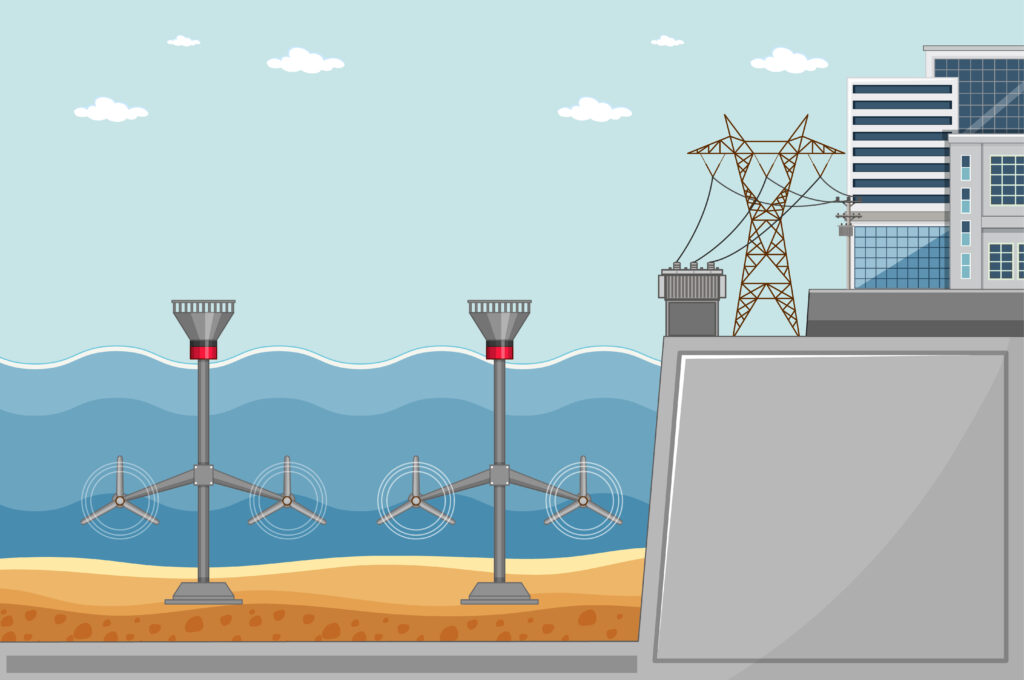
Finding sustainable and renewable energy sources has become crucial in the quickly changing world of today. “Wave Energy Converters” (WECs) are one such potential approach. These cutting-edge machines use the energy of waves in the ocean to generate clean electricity, which has a number of advantages. In this essay, we will look at 10 strong arguments in favor of “Wave Energy Converters” as the energy answer for a more promising and environmentally friendly future.
Table of Contents
1. Abundant and Endless Resource

Our planet’s huge seas provide a rich source of wave-stored kinetic energy. Wave energy is a limitless resource that is always being renewed by forces of nature like the wind and tides, unlike finite fossil fuels. With water covering over 71% of the Earth’s surface, the potential for harnessing this energy is nearly endless.
The interaction between wind and the ocean’s surface causes the waves to move consistently. The velocity of the wave is captured and transformed into electricity by specialized devices known as “Wave Energy Converters,” which are used to harvest this kinetic energy. Wave energy will continue to be produced as long as the Earth’s seas experience wind and tides, making it a dependable and steady source of energy.
2. Environmentally Friendly
The fact that “Wave Energy Converters” are environmentally friendly is one of its most important benefits. The energy generating method is a clean and sustainable substitute for conventional fossil fuel-based power plants since it produces no greenhouse gases, damaging pollutants, or toxic waste. We can dramatically lower our carbon footprint and fight climate change by utilizing wave energy.
When burnt to produce power, traditional energy sources like coal and natural gas release significant volumes of carbon dioxide and other pollutants. Contrarily, wave energy conversion generates little to no emissions, assisting in the reduction of both air and water pollution. Adopting this environmentally beneficial technology is in line with efforts being made worldwide to move away from fossil fuels and toward a more sustainable energy future.
3. Renewable and Predictable
Wave energy is far more predictable than certain other renewable energy sources, such as solar and wind. Since ocean waves are predictable, energy output can be accurately predicted, which facilitates integration into the current power grid. “Wave Energy Converters” offer a steady and dependable supply of electricity with few variations.
The production of solar and wind energy is frequently dependent on weather, which may be unpredictable and varied. In contrast, wave energy is impacted by constant elements that can be precisely predicted in advance, such as wave height, period, and direction. For grid operators and energy planners, this predictability is a vital asset that guarantees a continuous supply of electricity to fulfill demand.
4. Minimal Visual Impact
Renewable energy installations have not been widely adopted due to concerns about their aesthetic impact. Fortunately, it is possible to deploy “Wave Energy Converters” offshore, reducing their aesthetic influence on coastal environments. Because of this, conservationists and communities who value the preservation of picturesque vistas may find them to be a more enticing alternative.
The aesthetic issues that frequently surround onshore wind turbines or solar panels are addressed by placing “Wave Energy Converters” in offshore sites, which diminishes their sight from the coast. This design decision not only protects the coastal areas’ natural beauty but also creates new options for energy generation in locations where aesthetics are highly valued.
5. Low Operating Costs
“Wave Energy Converters” are quite inexpensive to operate once installed. Wave energy is free, requiring just minimum maintenance and monitoring, in contrast to conventional power plants that require constant fuel expenditures. Wave energy is a competitive option for electricity generating because of its affordability.
The majority of wave energy systems’ operational costs are related to maintenance, inspections, and repairs. Compared to fossil fuel-based power generation, where fuel prices can be unstable and lead to higher operational costs, the continuing costs are substantially lower because the energy source itself—the motion of ocean waves—is free and abundant.
6. Reduces Dependency on Fossil Fuels
Wave energy is a practical alternative as we work to lessen our reliance on limited and ecologically harmful fossil fuels. Nations may increase energy security and lessen sensitivity to changes in the price of oil by adopting “Wave Energy Converters,” which diversify their energy portfolios.
Fossil fuels are limited resources that exacerbate geopolitical unrest and environmental deterioration. Countries may reduce their reliance on fossil fuel imports, lowering their risk to supply interruptions and unstable market pricing, by introducing wave energy into their energy mix. This diversity improves energy independence and increases resilience at the international level.
7. Benefits Marine Ecosystems

“Wave Energy Converters” might build artificial reefs around their installations, giving marine life homes. These buildings can also serve as maritime protected areas, fostering biodiversity and aiding in the regeneration of fish populations. A healthy marine habitat may be promoted by promoting wave energy.
The underwater “Wave Energy Converters” constructions can foster the colonization of marine animals and increase biodiversity while acting as a home for a variety of aquatic organisms. Additionally, the vicinity of these sites may be declared as marine protected zones, which would limit human activities and promote the growth of marine organisms.
8. Job Creation and Economic Growth
The installation and upkeep of “Wave Energy Converters” can promote employment growth and boost the economy in coastal areas. Engineering, manufacturing, and maintenance professionals will be needed for the construction of wave energy facilities, creating significant job prospects for nearby areas.
Numerous job possibilities are generated by wave energy projects in a variety of industries, including production, installation, and continuing maintenance in addition to research and development. These employment openings can help local communities, and the infusion of qualified employees can promote economic development, better infrastructure, and an increase in commercial activity in coastal regions.
9. Global Applicability
The use of wave energy is not restricted to any one region. It may be used to generate electricity decentralizedly in coastal regions all over the world. “Wave Energy Converters” can contribute to energy production on a worldwide scale and have a wide variety of possible sites.
Due to the large dispersion of coasts across the world, wave energy offers a wider application than other renewable energy sources that are geographically constrained. This adaptability enables many locations to utilize their in-house wave resources and lessen their need on imported fossil fuels, making the global energy system more resilient and diversified.
10. Technological Advancements and Innovation
Investments in wave energy research and development are rising as interest in renewable energy sources develops. Wave energy is receiving more attention, and this increased attention is spurring technical development and innovation. “Wave Energy Converters” will advance in efficiency and cost-effectiveness with technology, securing their position as an essential energy option for the future.
The advancement of energy collection techniques, better materials, and more effective converter designs are all the results of research and invention in the field of wave energy technology. The cost-effectiveness and energy conversion efficiency of “Wave Energy Converters” are anticipated to rise as these developments carry on, making them more competitive with other renewable and conventional energy sources.
Conclusion
“Wave Energy Converters” have a great deal of potential as a dependable and sustainable energy source. In our quest for a cleaner future, their availability, environmental friendliness, and capacity to strengthen local economies make them a worthwhile investment. We can lessen climate change, lower our carbon footprint, and ensure a better future for future generations by embracing this cutting-edge technology.
Frequently Asked Questions (FAQ)
What are Wave Energy Converters (WECs)?
Innovative machines called Wave Energy Converters (WECs) use the kinetic energy of waves to generate useful power.. These devices are designed to capture the energy from the motion of waves and transform it into a clean, long-lasting energy source.
How do Wave Energy Converters work?
Wave Energy Converters work by utilizing different mechanisms to capture the energy from ocean waves. Some WECs use floating structures that move up and down with the waves, while others utilize oscillating water columns or other wave-based technologies to generate power. The captured energy is then transferred to onshore or offshore power stations for distribution.
What are the advantages of Wave Energy Converters?
Wave Energy Converters offer several advantages, including being an abundant and renewable energy source, environmentally friendly with minimal carbon emissions, predictable energy production, and the potential to benefit marine ecosystems by creating artificial reefs.
Are Wave Energy Converters visually intrusive?
No, Wave Energy Converters can be installed offshore, minimizing their visual impact on coastal landscapes. Unlike some renewable energy installations, such as wind turbines, WECs do not have a significant visual presence from the shore.
How reliable is wave energy as a power source?
Wave energy is highly predictable, which makes it a reliable power source. The consistent motion of ocean waves allows for accurate forecasting of energy production, making it easier to integrate into the existing power grid.
Do Wave Energy Converters have high operating costs?
No, once installed, Wave Energy Converters have relatively low operating costs. The energy source—the motion of ocean waves—is free and abundant, so ongoing costs are mainly associated with maintenance, inspections, and repairs.
Can wave energy reduce dependency on fossil fuels?
Yes, wave energy offers a viable solution to reduce dependency on finite and environmentally damaging fossil fuels. By incorporating WECs into the energy mix, countries can diversify their energy portfolios and enhance energy security.
What are the environmental benefits of Wave Energy Converters?
Wave Energy Converters produce clean electricity without emitting greenhouse gases or harmful pollutants, contributing to reduced air and water pollution. Additionally, they can create marine protection zones, supporting marine ecosystems and biodiversity.
Where can Wave Energy Converters be used?
Wave energy can be harnessed in coastal areas all around the world. Its global applicability makes it a versatile and decentralized energy generation model.

